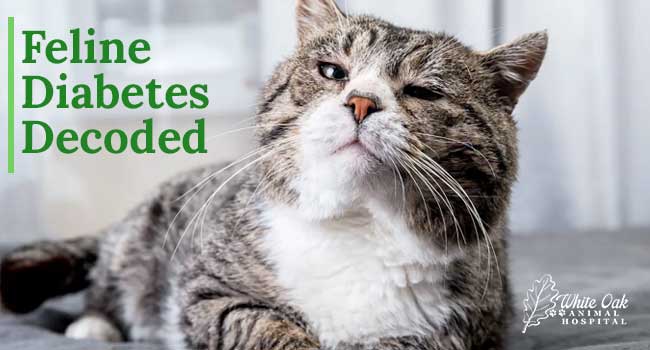
Feline diabetes is a metabolic disorder that affects cats, disrupting their ability to regulate blood sugar levels properly. This condition shares similarities with diabetes in humans but manifests uniquely in feline physiology. The significance of Feline diabetes for cat owners is immense, as it poses potential health risks and requires diligent management. Recognizing symptoms for early detection and management is of paramount importance.
Feline Diabetes can lead to serious complications if left untreated, such as kidney disease, neuropathy, and even life-threatening conditions like diabetic ketoacidosis. Timely intervention can help mitigate these risks and improve the quality of life for affected cats. Feline Diabetes demands vigilance, but its management can result in improved health outcomes and prolonged life for cats. Owners who stay alert to symptoms and work closely with veterinarians contribute significantly to their feline companions’ well-being.
Deciphering Feline Diabetes: Cracking the Code for a Healthier Cat
The relevance of Feline diabetes in the realm of cat health cannot be overstated. As a metabolic disorder, it not only affects how a cat’s body processes glucose but also has far-reaching implications for its organ systems. Cats with uncontrolled diabetes are at risk of experiencing adverse effects on their kidneys, nervous system, and even their eyesight due to the development of cataracts.
At its core, Feline diabetes significantly alters the way a cat’s body functions. Insulin resistance or inadequate insulin production leads to elevated blood sugar levels, a condition known as hyperglycemia. This persistent state of hyperglycemia can have cascading effects, contributing to weight loss despite an increased appetite, excessive thirst, and frequent urination.
Key Differences Between Feline Diabetes and Human Diabetes
Physiologically, Feline diabetes diverges from human diabetes due to the unique nature of feline metabolism. While both conditions involve improper regulation of blood sugar levels, the underlying mechanisms differ. Cats predominantly experience type 2 diabetes, characterized by insulin resistance and impaired insulin production, often linked to factors like obesity and genetics. In contrast, human diabetes encompasses both type 1 (insulin deficiency) and type 2 (insulin resistance), showcasing a broader range of causes and treatment approaches.
The 6 Telltale Symptoms of Feline Diabetes
Increased Thirst and Urination
Weight Loss Despite Increased Appetite
Lethargy and Weakness
Change in Grooming Habits
Sweet-Smelling Breath
The distinct odor arises from the cat’s body attempting to eliminate excess sugar through its breath, resulting in a mildly sweet or fruity aroma. This unusual breath odor, often accompanied by other symptoms, can be an important cue for cat owners to consider the possibility of feline diabetes. Cat owners who detect this sweet-smelling breath in their feline companions should be vigilant and seek veterinary attention promptly.
Cloudy Eyes (Cataracts)
Consequences of Untreated or Poorly Managed Feline Diabetes
Additionally, untreated feline diabetes can lead to secondary health issues, including urinary tract infections and kidney problems, as the elevated sugar levels in the urine create an environment conducive to bacterial growth. Vision problems, such as cataracts, can occur due to high blood sugar damaging the lens of the eye. Neglected this disease can also result in uncontrolled weight loss, as the body breaks down muscle for energy when glucose is unavailable. Furthermore, cats with unmanaged diabetes are at a higher risk for heart and circulatory problems.
Diagnosis and Treatment of Feline Diabetes
Diagnosing this disease involves a comprehensive approach that typically includes blood tests and urinalysis. These diagnostic tools help veterinarians assess the cat’s blood sugar levels and the presence of glucose in the urine, both of which are crucial indicators of diabetes. Blood tests measure glucose concentrations in the blood, highlighting any persistent hyperglycemia that might point toward feline diabetes. Similarly, urinalysis detects elevated glucose levels in the urine, a sign that the kidneys are excreting excess glucose.
Upon diagnosis, a multifaceted treatment plan is essential for managing feline diabetes effectively. Dietary changes constitute a cornerstone of treatment, emphasizing high-protein, low-carbohydrate diets tailored to a cat’s carnivorous nature. This approach helps stabilize blood sugar levels and supports weight management.
Cat owners are encouraged to prioritize their pet’s health by promptly seeking veterinary care if they suspect feline diabetes. Early diagnosis enables veterinarians to develop tailored treatment plans, which may include dietary adjustments, insulin therapy, and lifestyle modifications. For the best care, White Oak Animal Hospital emerges as a reliable option, boasting over 28 years of experience and having treated more than 6,000 pets.
White Oak Animal Hospital offers a unique advantage with integrative options not available elsewhere, including TCVM Telemedicine consultations. This holistic approach addresses feline diabetes comprehensively, addressing both traditional and alternative therapies. By choosing White Oak Animal Hospital, cat owners can access specialized care that caters to their pet’s unique needs, enhancing their chances of effectively managing feline diabetes and ensuring their beloved companions lead healthier, happier lives.